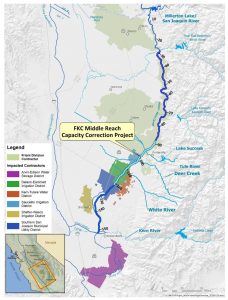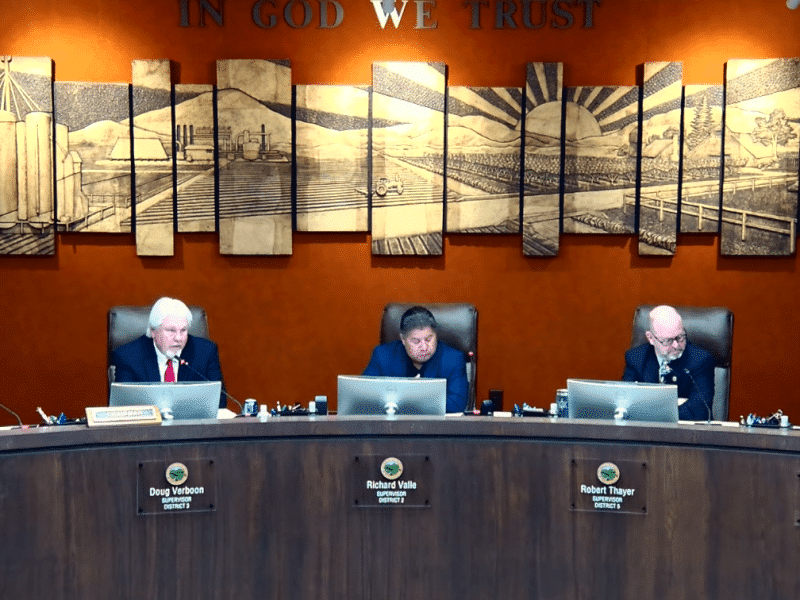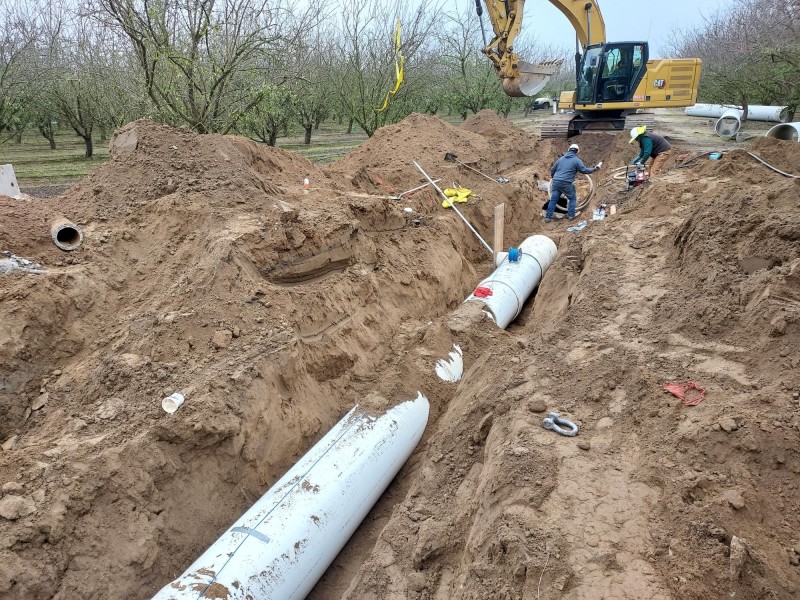Counting groundwater: The devil is in the details
A lengthy complaint alleging secretive, self-dealing on the part of a prominent farmer and board member on a key Tulare County groundwater agency slogged through a Fair Political Practices Commission investigation over the past four years resulting in, essentially, a slap on the wrist late last month.
Eric L. Borba, former chair of the Eastern Tule Groundwater Sustainability Agency, was found in violation of the state’s disclosure rules at the Commission’s April 25 meeting for not listing his ownership in several ditch companies including the value of those water assets. He was ordered to revamp his Form 700s, which public board members and executives must file each year, and pay a $5,400 fine.
The Form 700s now list Borba’s ownership, through a variety of entities, in five area ditch companies. Specifically, he owns 13 shares in the Hubbs & Minor Ditch Company, 14 shares in the Porter Slough Ditch Company, 18 and ⅓ shares in the Gilliam-McGee Ditch Co., 61.5 shares in the Pioneer Water Co. and 9.9283 shares in the Poplar Irrigation Company, according to a letter from his attorney to the FPPC obtained by SJV Water through a Public Records Act request.
The values of those ditch company shares are listed at up to, or more than, $1 million each on Borba’s updated Form 700s.
That’s significant information that the public should have known back in 2018-2020 when the Eastern Tule GSA was developing and implementing its groundwater accounting policies, according to the FPPC complaint filed by farmer Bill Samarin in early 2020.
Borba recently stepped down as chair of Eastern Tule but is still on the board. He is also listed as the president of the Porterville Irrigation District, one of five surface water districts that operate within the GSA.
He declined to comment when contacted by SJV Water.
Samarin, who sold his farms and moved out of Tulare County, also declined to comment.

Time running out
Those same groundwater accounting policies that piqued Samarin’s suspicions are now also the focus of a lawsuit by the Friant Water Authority against Eastern Tule for continued – and accelerated – sinking along the Friant-Kern Canal that was recently rebuilt because of previous subsidence.
Eastern Tule has disputed the allegations in the lawsuit and its General Manager Rogelio Caudillo has said the agency is diligently working to get landowners on board with new pumping restrictions and costs.
In fact, the board recently approved approximately $2.4 million in liens against about 60 of its landowners for not paying required pumping fees.
But time is rapidly running out for Eastern Tule, and the Tule subbasin as a whole, to show it’s making strides toward getting its groundwater house in order as mandated by the Sustainable Groundwater Management Act.
After twice failing to come up with a plan to curb overpumping in order to, among other things, stop rampant subsidence along the Friant-Kern Canal, the subbasin is now facing a probationary hearing Sept. 17 before the state Water Resources Control Board.
Probation is the first step toward a possible state pumping takeover.
The latest wrinkle is that two of five water districts in the GSA are scheduled to vote Monday to pull out of Eastern Tule. The Vandalia and Tea Pot Dome water districts both have resolutions to leave and form their own GSAs, which could further complicate the Tule subbasin’s fate at the Water Board hearing.
Groundwater ingo/outgo
Though the FPPC didn’t find merit in the more serious allegations leveled against Borba – including perjury and intentionally hiding assets for personal gain – the accounting policies approved by the board under Borba’s leadership do place him and others with surface water in a position to profit substantially.
So how does groundwater accounting work?
Under SGMA, GSAs are tasked with tracking every drop that goes into and and comes out of their aquifers, which must be in balance by 2040.
Numerous GSAs, including Eastern Tule, have set up online dashboards so they and their farmers can track that ingo/outgo on an individual level.
Dashboards account for everything from how much rain falls on the GSA to how much water is imported and recharged into the aquifer. And they debit amounts used by farmers for irrigation.
Water credit dump
But Eastern Tule has done a few things differently.
Before the dashboard became operational in 2022, some farmers got a dump of water credits into their accounts from surface water districts within Eastern Tule. Those districts gave their farmers credits equal to the total amount of surface water they had used for irrigation over the previous five years
It’s unclear if those amounts were reduced by the amount of water consumed through irrigation. That appears to have been left up to the discretion of each of the five water districts, which include: Porterville Irrigation District, where Borba is listed as the board president; the Saucelito and Terra Bella irrigation districts; and the Teapot Dome and Vandalia water districts.
In many cases those deposits added up to 10s of 1,000s of acre feet of water.
That was significant for surface water owners, such as Borba.
Most Eastern Tule lands aren’t covered by water districts. Farmers on those lands rely almost exclusively on groundwater. Samarin’s 2020 FPPC complaint notes 94% of Eastern Tule’s farmers don’t have surface water.
That water credit dump put the few farmers with surface water in an automatic seller’s position with a captive market.
Moving the rain
Another devil buried in the details of Eastern Tule’s accounting is how rainfall is tallied and treated.
The Eastern Tule board gave each of its farmers credits for two year’s worth of precipitation from 2020 and 2021. Those amounts did not subtract how much of that rainfall was used up by plants.
The rainfall credits are allowed to roll over after a year and become groundwater credits that farmers can then sell or use anywhere within the 85,000 acres covered by the GSA, or even outside of Eastern Tule’s boundaries.
Other groundwater agencies measure the rain as it falls and apply it to the evapotranspiration (how much plants soak up and expire) needs of farmers’ crops. It’s used where it falls and is the first water taken out of farmers’ accounts, explained Aaron Fukuda, Executive Director of the Mid-Kaweah GSA and General Manager Tulare Irrigation District.
“Giving rainfall as a credit and then allowing that credit to be transferred is going to create a problem,” he said. “That rainfall was already used.”
Pumping credits
Eastern Tule also allows farmers – not the GSA – to choose which pot of water (rainfall, groundwater, surface water, etc.) is debited and which credits are rolled over to following years.
That could be especially helpful for the few Eastern Tule farmers with surface water as they can bank up certain credits and sell others to farmers without credits who can then use them to pump more than they would otherwise be allowed to.
Critics call this using paper credits to pump real groundwater, which has real consequences.
In his 2020 FPPC complaint Samarin noted that Borba “…will be able to market a new kind of highly profitable water trade called ‘Groundwater Pumping Credits’ on a Water Market System that he has influenced to design and approve.”
It’s unclear if Borba, in fact, has profited from the accounting policies as his groundwater credits, use and sales records were not disclosed by Eastern Tule per a Public Records Act request submitted by SJV Water.
Such records for utility board members are required to be disclosed under the California Public Records Act. But, Eastern Tule noted that requirement doesn’t extend to companies or entities, only persons who serve as board members. Borba’s groundwater accounts are under various entities and so were exempted from disclosure.

Still sinking
Regardless of who may have profited from the accounting policies, what is clear is the policies have also kept many Eastern Tule farmers from dipping into what’s known as “penalty pumping.”
The penalty category covers pumping that’s beyond what farmers have banked up as credits. Penalty pumping costs between $310 and $500 per acre foot.
That penalty pumping money was expected to bring in about $200 million over time and be paid to the Friant Water Authority for Eastern Tule’s share of the cost to fix the Friant-Kern Canal per a 2021 agreement between the two entities.
So far, Eastern Tule has only paid Friant a little more than $17 million since 2021. Meanwhile, the canal has sunk faster and in more places than was anticipated, according to Friant’s lawsuit.
“We were all predicting they would have 60,000 to 80,000 overdraft (penalty) pumping,” Jason Phillips, General Manager of Friant, told SJV Water when the lawsuit was filed in February. “But (penalty) pumping has only been about 15,000 acre feet a year. And, ironically, subsidence is still the same.”
Friant’s lawsuit targets Eastern Tule’s accounting practices for shorting the authority and allowing over pumping unabated.


